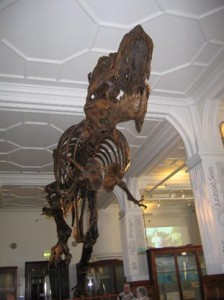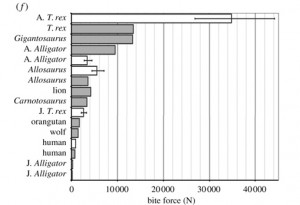T. rex Bite More Powerful than Previously Thought and the Bite became more Powerful as they Grew
New research into the biting power of adult tyrannosaurs by UK based researchers indicates that the bite force of an adult Tyrannosaurus rex was higher than previously thought. In addition, this new study, results of which appear in the scientific journal “Biology Letters”, suggests that the bite became disproportionately more powerful as this predator grew and matured.
Tyrannosaurus rex
The bite force generated by extinct predators such as Tyrannosaurus rex has been studied before, but this new study suggests that the bite force generated on the points of the back teeth of this dinosaur’s formidable jaws is much higher than previously thought, with T. rex having the strongest bite of any known terrestrial animal.
Dr Karl Bates, a researcher at the University of Liverpool’s biomechanics laboratory and his colleague, Peter Falkingham (Manchester University), used a life-size, computer generated copy of the STAN-BHI3033 specimen’s skull to carry out their research. This T. rex specimen was discovered in 1992 by Stan Sacrison, hence the specimen name.
Dr Bates explained:
“We digitised the skull with a laser scanner, so we had a 3-D model of the skull on our computer.”
We at Everything Dinosaur, known this specimen very well and we have had the privilege to work with elements of the skull including the dentary, the skull of this particular T. rex is exceptionally well-preserved and almost complete.
The Reconstructed STAN-BHI 3033 Replica (Manchester Museum)
Picture credit: Everything Dinosaur
Three-dimensional Images
Once the three-dimensional image had been created, the muscles that articulated the jaws and the skull could be mapped onto the image. The researchers could then reproduced the full force of a bite by activating the muscles to contract fully – snapping the digital jaws shut. A number of extant animals were also mapped in this way, the bite force of an alligator was modelled using this technique and then compared to known data to test the validity of this methodology.
Dr Bates stated that this new research gives T. rex an even more powerful bite than previously thought, he declared:
“Those [simulated] muscles closed the jaw as they would in life and we measured the force when the teeth hit each other. The maximum forces we found – up at the [back] teeth – were between 30,000 and 57,000 Newtons.”
At Everything Dinosaur, we have been working on some comparative data on the toothsome properties of large tyrannosaurids and spinosaurids. Bite force estimates are difficult to calculate, especially in the absence of any extensive large spinosaur (S. aegyptiacus) fossil material, but in our studies the bite force of a large T. rex was estimated to be around 12-15,000 psi (pounds per square inch) comparable with the Liverpool research.
The Bite Force of a T. rex
As an approximate guide, to convert Newtons to lbs per square inch bite force divide by 4.45 (rounded).
When asked to give a “layman’s perspective” regarding the power of a T. rex bite, the scientist compared the bite force generated to the equivalent of a medium-sized elephant sitting on a person.
Computer Model Used to Estimate T. rex Bite Force
Picture credit: Biology Letters
Earlier studies had estimated that an adult T. rex had a bite force of perhaps 13,000 Newtons, still a powerful bite, but nowhere near the figure given by this new research.
The picture above shows the computer generated model of the T. rex skull with the musculature involved in closing he jaws mapped onto the bone. The first picture on the left – (a) three-dimensional digitised skull with soft tissues reconstructed for mass and muscle properties (red, adductor mandibulae externus group; blue, adductor mandibulae posterior group; purple, pterygoideus group). The second image (b) shows the model with joint centres (green circle), muscles (red cylinders), and ‘contact’ springs (blue spheres and cylinder) on the teeth in the initial simulation starting pose. The final picture shows the model in the “sustained biting” position.
The British scientists developed their work on the T. rex bite force. As well as comparing their data with previous tyrannosaur studies, they mapped the bites of other large theropods including allosaurids such as Giganotosaurus carolini and other tyrannosaurs. In addition, they looked at tyrannosaur ontogeny (how animals grow). Their work suggests that as the head of T. rex got bigger there was an expected increase in bite force, but the jaws seem to have got disproportionately stronger the bigger the animal got.
Explaining the findings, Dr Bates stated:
“Obviously, as its head got a lot bigger, there’s an expected increase in bite force associated with that. But for T. rex, the power behind its bite increased disproportionately – much more than would be expected from a straightforward linear increase.”
Although only speculation, the disproportionately stronger jaws in older individuals may suggest that this predator’s diet changed as it matured. With perhaps only the biggest tyrannosaurs able to take on the largest contemporaneous animals, that co-existed with the “Tyrant Lizard King”.
A Table Showing the Bite Force Comparisons of Animals and Previous Research Figures
Picture credit: Biology Letters
The graph shows the results of the Manchester/Liverpool research (white bars) on animals such as adult T. rex, juvenile T. rex, Allosaurus, alligators et al. The grey coloured bars show the results of previous research studies into those animals and their respective bite forces.
Dr Bill Sellers, (University of Manchester), a scientist who has carried out a lot of computer-based comparative research on dinosaurs commented:
“I think everyone expected T. rex to have a strong bite force, but it’s even stronger than we expected. It gets stronger as it gets bigger, which is surprising.”
He explained that studying dinosaurs shed light on the limits that living things were capable of.
“These animals are extremes – one of the biggest carnivores that ever lived. So it tells you a lot about the limitations of biology. We want to know how organisms work, but living organisms are much smaller. In terms of mechanics, size is really important.”
Bite force data can be interpreted in many ways, the lack of observed results and the limits placed on the research by the paucity of the fossil record are problematical, however, with the latest computer generated models, a more accurate measurement can be obtained. Whichever figure is taken, it is clear from only a cursory examination of the jaws and teeth of a tyrannosaur, that the front end of this particular dinosaur was to be avoided at all costs.
It is worth noting that the specimen adult T. rex studied was a gracile form, larger tyrannosaurs, more robust T. rex fossils are known and these animals may have had even stronger bites.
To view models and figures of Tyrannosaurus rex and other prehistoric animals: PNSO Dinosaur Models.









Found this article very interesting, but also very worried to hear that T. rex is an extant predator. OMG !
If only more Spinosaurid cranial material could be found, then this modelling technique could provide insights into the potential bite force of large members of the Spinosauridae as well.
Yes, you are right – The BBC documentary is entitled “The Truth about Killer Dinosaurs” – we have worked with the BBC on a number of projects. In this programme a metal scale model of T. rex jaws were made and it crunched a car. We also learnt Triceratops did not charge its naris was to fragile and would have broken if it had been put under substantial impact stress. This programme is available on DVD – our knowledge has moved on a bit but the programme is still worth watching especially the early work on the Dromaeosaur killing claw which was ahead of its time.
the deinosuchus -giant shark and large pliosaurs have stronger bites than this and it was proven in various documentaries for each beast-deinosuchus is underestimated after the downgrading of size but larger fragments of giant deinosuchus specimens are known-dr schimmer stated such in the book it wrote-it was equal to rex or slightly more-the norway and dorset pliosaurs have massive bites few time greater than t-rex -and the giant shark can bite through a truck as shown in documentaries about in the documentary channels-they were very strong much more than crocodiles.
Tyrannosaurus rex – estimated to have the largest bite force of a terrestrial animal – land living. Stronger bite forces are estimated for nektonic – active swimming animals due to the environment in which they are in. We explain this by getting people to imagine how difficult it is to bite into an apple when “bobbing for apples”.
In fact T-rex had the most strongest bite of any animal.
Bite Forces:
T-REX = 8,000-12,000 lb-force; animal unarmored.
Sarcosuchus Imperator = 18,000-20,000 lb-fore; animal armored.
Deinosuchus riograndensis = 23,000 lb-force; animal armored.
>> T-REX = Lunch (^_^)…
=====================
You forgot that Pliosaurus funkeii has the strongest bite at 4, 10, 0r 11 times that of the T. rex. This means it bit with an average force of 433,864.77 Newtons or 97,536.68 psi! Meg could only bite with a force of up to 182,201 Newtons or ~40,544 psi! Duh!
I did the math, too.
Even 4 times the T. rex’s bite is stronger than Megs. Plio also could see 10x better than us humans underwater.
Deinosuchus was also up to 16 meters or ~52.5 ft long and weighed 16,000+ kg, and bit with a force of 102,803 Newtons or ~23,111 psi!